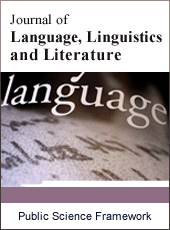Journal of Language, Linguistics and Literature
Articles Information
Journal of Language, Linguistics and Literature, Vol.4, No.4, Dec. 2018, Pub. Date: Dec. 6, 2018
Words Which in the Old of Uzbek the Concept of Noun Is Express
Pages: 70-73 Views: 2347 Downloads: 445
[01]
Abdulla Urazbayev, Department of Uzbek Linguistic, Faculty of Philology, Urgench State University, Urgench city, Uzbekistan.
[02]
Sherjonova Gulruxsor, Department of Uzbek Linguistic, Faculty of Philology, Urgench State University, Urgench city, Uzbekistan.
[03]
Yusupova Quvonchoy, Department of Uzbek Linguistic, Faculty of Philology, Urgench State University, Urgench city, Uzbekistan.
This article is described “ot” meant words in the old Uzbek and their linguistic-esthetic in Ogahiy’s historical works. The article is decribed the synonims and Lexical meanings of the word “ot” which was used in old Uzbek. In the description of the word were used many researchwork of linguists and lingual dictionaries. Good examples which described the meaning of “ot” were given, especially in Ogahi’s historical works. Besides it, descriptions of meaning of the words were explained in Makhmud Koshgar’s work “Devonu lugotit-turk”, Yusuf Xos Hojib’s work “Qutadg’u bilik” and “Navoiy asarlari lug’ati”. Words of horse concept expressing were used more in old Uzbek and they give a few opportunities to understand writer’s idea via clearly and literature varicolored. Researchers say below used “ot” concept in the old Uzbek and definition of their linguistic-esthetic in Ogahiy’s historical plays. In Ogahiy’s works it was described what expressed words the concept of “animal” and gives several zoological terms. Informations which were given in the article prove how is broad the opportunity its lexical opportunity.
The Old Uzbek, Historical Lexica, Historical Play, Zoological Term
[01]
Yuldashev R. The field of "hunting" content in the poet's poetry // Science pockets, 2005, 4th edition. - B. 78-82.
[02]
Nuriyeva A. X. Tatar-Mongolian lexical parallels and the definition of Mongolism // Turkic linguistics. - Tashkent: Fan, 1985. - p. 379.
[03]
Shcherbak A. Names of domestic and wild animals in Turkic languages // Historical development of the vocabulary of Turkic languages. - M.: Publishing House of the Academy of Sciences. - WITH. 83
[04]
Shir Muhmmad Mirab Munis and Myhmmad Riza Agahi. Firdavs al-iqbal: History of Khorezm / Edited by Yuri Bregel. T. J. Brill. - Leiden-New York-Kobenhavn-Koln, 1988. (Given abbreviation FI); oriental stadies 5364 / II of the Oriental Studies Institute of the Academy of Sciences of the Republic of Uzbekistan. 246a-364a pages (Given abbreviation RD); زبدة التواررح The Oriental Studies Institute of the Academy of Sciences of the Republic of Uzbekistan. 821 / III. Pages 386a-435a (issued abbreviated to ZT); Glsn dwlt your own RFA Institute of Oriental Studies, №7572 (Given abbreviation GD); جامع الواقعات سلطاني Institute of Oriental Studies, RFA, № 9786 (Given abbreviation JVS); شاهد الاقبال Photograph of the manuscript kept in St. Petersburg / Institute of Oriental Studies of the Academy of Sciences of Uzbekistan 70/1, 70/2 (Given abbreviation SHI)
[05]
Fakhriddin Ali Safiy. Latawhip (Latâbît ut-tawâif). Hoja Sotimxon Hoja In'om Munavvar translated from persian. - Tashkent: Literature and Art Publishing named after Gafur Gulom. 1996. - B. 7.
[06]
Ibrohimov S., Shamsiev P. Alisher Navoiy's Dictionary. - Tashkent: Publishing house Gafur Gulom. 1972. - B. 584.
[07]
Budagov L. Z. Comparative dictionary of Turkish-Tatar dialects. Volume 2. - St. Petersburg, - P. 394.
[08]
Shams al - Din Muhammad ibn Khalaf Tabrizi. Proven proof. The attention of Daktar Mohammed Maayan. Tehran. Great Amir. 1386. Leathe. БҚ – Б. 534.
[09]
Mahmud Koshgari. Devon lugati turk. Translator and publisher S. Mutallibov. -Tashkent: Uz FAN, 1960. - B. 382.
[10]
Edelman D. I. Once again about the stages of affiliation of the Aryan linguistic community // Questions of linguistics. Number 3. 1992. - p. 49.
[11]
Kutadgu bilig. III Index. The index is prepared by: Kemal Eraslan, Osman F. Sertkaya, Nuri Yuce. Turkish Culture Research Institute Publications: 47. Series IV - A. 12. Istanbul. 1979. - P. 539.
[12]
Hasanov B. A short dictionary of Navoi's works. - Tashkent: Science, 1993. - B. 109.
[13]
The sacrifice of God is a description. History of the Literature of Iran. Dom skin.
[14]
Budagov L. Z. Comparative dictionary of Turkish-Tatar dialects. Volume 2. - St. Petersburg, - p. 138.
[15]
Navoiy works dictionary. - B. 321.
[16]
The dictionary of Alisher Navoiy's works. Volume 2. - Tashkent: Science, 1983. - B. 137.
[17]
Farhang Laroussi Arabi-Farsi. Translated from Arabic. Tehran: Amir Kubir 1380 AH P. 1732
[18]
Bahrami E., Jonnaydi F. Dictionary of the Avesta. Bonyod-e Nishopur. Vol. 1. – P. 27.
[19]
Shams al - Din Muhammad ibn Khalaf Taborizi. Proven proof. The attention of Daktar Mohammed Maayan. Tehran. Great Amir. 1386. Leather 4
[20]
Freiman A. A. Khorezmian language. Materials and Research I. - M.-L.: Publishing House of the Academy of Sciences. 1951. - P. 42 ¬– 44.
[21]
Persian-Russian dictionary. Volume I. - M.: Russian, 1983. - P. 710.
[22]
Shams al - Din Muhammad ibn Khalaf Tabarizi. Proven proof. The attention of Daktar Mohammed Maayan. Tehran. Great Amir. 1386
[23]
Navoiy works dictionary. - Tashkent: Literature and Art Publishing named after Gafur Gulom, 1972. - B. 31.
[24]
Mazandrani Husayn Shahid Farhang Shahnama (Nam Xsan and Jaha) Balkh Beniad Nashapur 1388. P. 346

ISSN Print: 2381-7054
ISSN Online: 2381-7062
Current Issue:
Vol. 6, Issue 1, March Submit a Manuscript Join Editorial Board Join Reviewer Team
ISSN Online: 2381-7062
Current Issue:
Vol. 6, Issue 1, March Submit a Manuscript Join Editorial Board Join Reviewer Team
| About This Journal |
| All Issues |
| Open Access |
| Indexing |
| Payment Information |
| Author Guidelines |
| Review Process |
| Publication Ethics |
| Editorial Board |
| Peer Reviewers |


